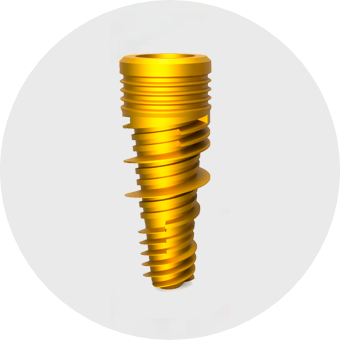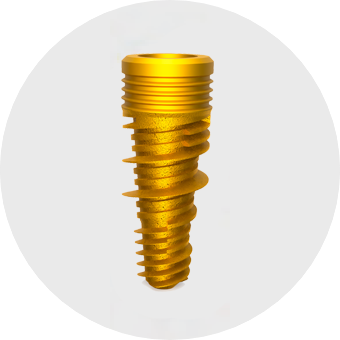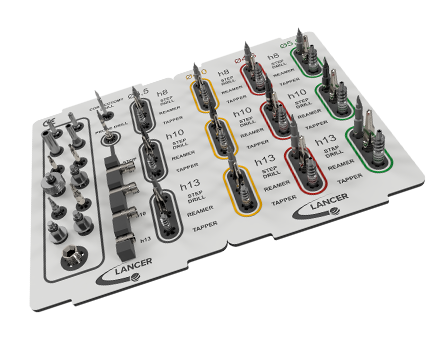EVO IMPLANTS
Conical Titanium Grade 5 implant with internal hexagon for the submerged technique with two surface variants available: Acid Etched (MAC) or Titanium Plasma-Spray (TPS) sandblasted, both TiN-coated.

MAC
Surface

TPS
Surface
The cono-morse connection is today the most versatile prosthetic connection for both screw-retained and cemented prostheses.
The morphology of the EVO implant (with its cylindrical body in the coronal part and conical in the medullary part, the large self-centring coils with 1.5 mm pitch and the osteogenic corrugations), allows an atraumatic implant insertion for the patient, with long-term follow-up (more than 25 years).
The EVO implant also has a three-principle apical coil with a 0.5 mm pitch that promotes primary stability.
– ATRAUMATIC SURGERY
– PRIMARY HEALING
– SINGLE PROSTHETIC CONNECTION FOR ALL DIAMETERS
– 6° CONOMETRIC CONNECTION
– PLATFORM-SWITCHING WITH THREE PROFILES OF EMERGENCY FOR PROSTHETIC COMPONENTS
– TITANIUM NITRIDE (TiN) COATING ON ALL IMPLANTS AND DEFINITVE PROSTHETIC COMPONENTS
Lancer is proud to introduce the EVO internal hex implant solution.
The term EVO, meaning “evolution”, is intended as a symbolic transition from the historic PHI transmucosal line with internal hexagon and final cemented prosthetic components created in 1991 to a revised and updated line that meets the current needs of dentists and dental technicians, a submerged implant with prosthetic components with a through screw, conometric connection (6°), platform-switching and abutments without a shoulder (to finish).
The EVO line, marks the achievement of PHI’s maturity with unique features, summarises the best knowledge in implant prosthetics, and is constantly evolving.
The EVO line is the result of the development of mechanical concepts that are well established in the dental world and set the benchmark for implant surgery in terms of quality, ergonomics, and a fair price.
The line includes implants with variable incremental diameters, all sharing the same platform and implant connection, to facilitate their use during the prosthetic phases; PHI EVO implants have a single prosthetic connection for all implant diameters, allowing the interchangeability of prosthetic components.
Prosthetic components
• Angled titanium abutments
• Straight calcinable abutments
• Prosthetic screw
• Extractor for EVO abutments
• Abutment for bonding
• Toronto abutment
• Scan-body/scan-abutment
• Ti-base EVO
• Cad Cam EVO analog
• EVO premilled
COMBINED ACID ETCHING (MAC)
It is designed to significantly increase the contact surface and promote the differentiation of osteoblastic cells.
There is an extensive bibliography about this surface treatment, its efficacy, and long-term stability, making the device suitable for standard conditions and with suboptimal bone quality or quantity.
The MAC treatment significantly increases the “% area increase” value, which represents the contact surface between the implant and the bone.
This type of treatment is reliable and has been used for several years with excellent results. The surface has an average Sa surface roughness of 1.3 μ.
TITANIUM PLASMA SPRAY (TPS)
This process is carried out by means of an electric arc plasma burner that raises
the temperature of a noble gas in which Titanium powders are sprayed.
The most superficial layers of these powders melt, bonding to the body of the implant on which they are deposited.
Several studies have shown that Titanium plasma-spray preparation not only increases the surface area available for bone adhesion, but it also induces an increase in the proportion of implant surface area that comes into contact with mineralised tissue, in comparison with smooth titanium implants.
In clinical terms, these phenomena are reflected in a stronger bone anchorage of the implant.
TITANIUM NITRIDE (TiN) COATING
All implants in the PHI EVO line feature Titanium Nitride (TiN) coating.
Thanks to PVD technology, the coating isolates the substrate, creating a barrier that produces a high-quality, consistent coating with a dual value: aesthetic, because the gold color does not reveal the implant against the light through the mucous tissue, and bibliographic studies have shown that it prevents negative bacterial proliferation compared to an untreated surface.
Importantly, TiN coating only modifies the surface properties of the implant without altering the substrate properties and biomechanical functionality.
Evo standard tray
Surgical Kit
• Frese a gradini Ø4.0; 4.5; 5.0 x H.8; 10; 13 mm
• Alesatori Ø4.0; 4.5; 5.0 x H.8; 10; 13 mm
• Maschiatori Ø4.0; 4.5; 5.0 x H.8; 10; 13 mm



